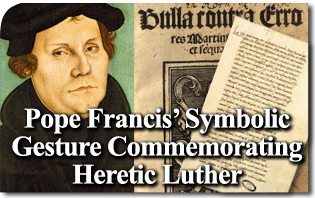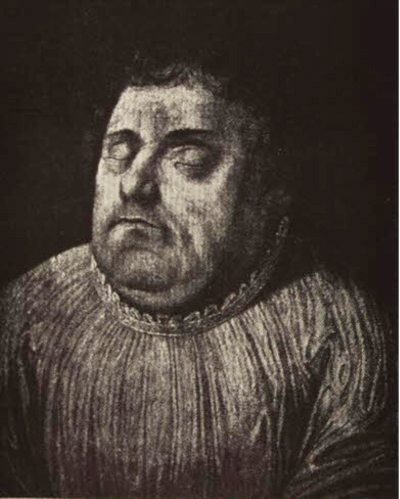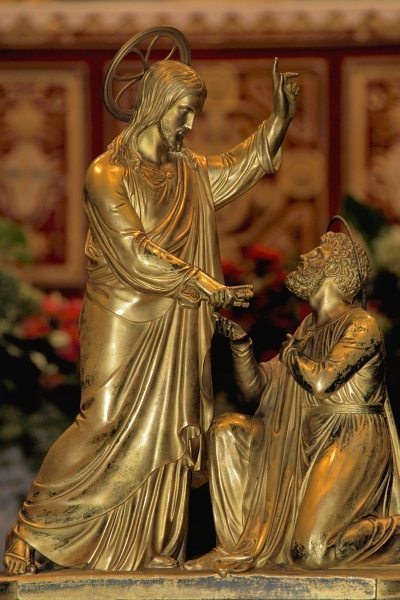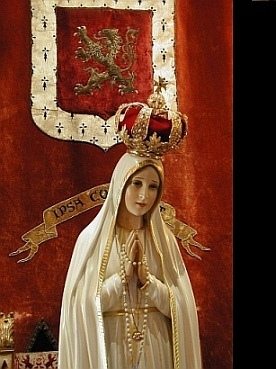 Symbolic acts and gestures often have a greater persuasive power than words and reasoning, though one completes the other. This is why the Divine Savior constantly used both symbolic gestures and employed metaphors and parables.
Symbolic acts and gestures often have a greater persuasive power than words and reasoning, though one completes the other. This is why the Divine Savior constantly used both symbolic gestures and employed metaphors and parables.
This is also why the Church has always surrounded herself with symbols to make visible the beauty of her doctrine, the sacredness of her liturgy, and the dignity and authority of her hierarchs. The pope was solemnly crowned to symbolize the power given to him by Our Lord as the successor of Saint Peter in the governance of the Church and guidance of Christendom.
Teaching by Symbolic Acts
The current Pope uses many symbolic gestures and teaches more through acts and attitudes than actual words, although unfortunately the words are often employed in a confused and even scandalous way, such as his famous “Who am I to judge?”
Along the lines of his teaching through acts and gestures, his announced participation in the commemoration of the revolt by the apostate and heretical monk Martin Luther is of the utmost gravity.
As reported by the Vatican Informative Service on January 25, this year Francis will go to the city of Lund, Sweden, where together with Lutheran leaders he “will preside at a joint commemoration of the Reformation on 31 October.”1 As you will recall, it was on this date in 1517 that Luther is said to have posted his ninety-five theses on the door of the church of Wittenberg castle.2
Commemorating a historical fact is not merely recalling it as one would in a history lesson. It is a festive remembrance and praise of something deemed worthy of admiration, imitation or even devotion. That is why in 2017 the Catholic world will commemorate the centennial of the apparitions of Our Lady at Fatima.
How can Pope Francis actively participate in commemorations of Luther’s revolt against the Church and the papacy without giving Catholics and non-Catholics the impression that he admires the action and doctrines of that heretic?

Solemn Condemnation of Luther’s Errors
It is well to recall that Pope Leo X, with the Bull Exsurge Domine of June 15, 1520, invoking the Divine authority and that of the Holy Apostles Peter and Paul and his own, solemnly condemned forty-one errors advocated by Luther in 1517:
[W]e condemn, reprobate, and reject completely each of these theses or errors as either heretical, scandalous, false, offensive to pious ears or seductive of simple minds, and against Catholic truth. By listing them, we decree and declare that all the faithful of both sexes must regard them as condemned, reprobated, and rejected . . . We restrain all in the virtue of holy obedience and under the penalty of an automatic major excommunication.
In like manner, the Pope then condemned other writings by Luther:
Moreover, because the preceding errors and many others are contained in the books or writings of Martin Luther, we likewise condemn, reprobate, and reject completely the books and all the writings and sermons of the said Martin, whether in Latin or any other language, containing the said errors or any one of them; and we wish them to be regarded as utterly condemned, reprobated, and rejected. We forbid each and every one of the faithful of either sex, in virtue of holy obedience and under the above penalties to be incurred automatically, to read, assert, preach, praise, print, publish, or defend them.3
Furor Against the Papacy
In his arrogant and vulgar style, the heretic’s response was a pamphlet on November 4 of the same year titled, “Against the Execrable Bull of the Antichrist,” which proclaimed:
You then, Leo X, you cardinals and the rest of you at Rome, I tell you to your faces…. I call upon you to renounce your diabolical blasphemy and audacious impiety, and, if you will not, we shall all hold your seat as possessed and oppressed by Satan, the damned seat of Antichrist.4
Luther’s wrath against the papacy led him to use more and more vulgarity, going so far as to promote unimaginably offensive engravings.
With an apology to the reader, we quote here a sample. It is an assessment by a Protestant historian of Luther’s libel Against the Papacy at Rome, Founded by the Devil, published by the review of the Lutheran Church-Missouri Synod, Concordia Theological Quarterly:
Luther outdid even the violence and vulgarity of Against Hanswurst [attacking the Catholic Duke Henry of Brunswick.] in his 1545 Against the Papacy at Rome, Founded by the Devil. On the heels of these treatises he published a series of scatological and violent woodcuts that, in most graphic terms, suggested how good Christians should treat the papacy. In these and other treatises, Luther bestialized his opponents, most frequently likening them to pigs or asses, or called them liars, murderers, and hypocrites. They were all minions of the devil. He directed the devil to his ass, he renamed the papal decretals “decraptals” [Drecketalen] and the Farnese pope “Fart-ass” (farlz Esel) and “Her Sodomitical Hellishness Pope Paula III,” [Pope Paul III, 1534-1549] and he threw around words for excrement with great abandon. In the woodcuts by Lucas Cranach that Luther commissioned at the end of his life, he had the papal church depicted as being expelled from the anus of an enormous she-devil and suggested, once again in picture, that the pope, cardinals, and bishops should be hung from gallows with their tongues nailed alongside.5
The same article reports:
When asked why he had published the cartoons, Luther replied that he realized that he did not have long to live and yet he still had much which ought to be revealed about the papacy and its kingdom. For this reason he had published the pictures, each a whole book’s worth of what ought to be written about the papacy. It was, he stated, his testament.6
In 1529, Luther proclaimed:
Under popery we were possessed by one hundred thousand devils.7
One of Luther’s mildest criticisms of the Pope is found in this commentary in Table Talk:
Antichrist is the pope and the Turk together; a beast full of life must have a body and soul; the spirit or soul of antichrist is the pope, his flesh or body the Turk. The latter wastes and assails and persecutes God’s church corporally; the former spiritually and corporally too, with hanging, burning, murdering, etc.8
Doctrine of False Mercy
The essence of Luther’s doctrine is justification by faith alone. But the consequence of that doctrine is a false concept of God’s mercy. Fr. Serafino Lanzetta, analyzing the book of Walter Cardinal Kasper, Mercy: The Essence of the Gospel and the Key to Christian Life, writes:
Historically, in Kasper’s judgement, supported by O. H. Pesch, “the idea of a chastising and vindictive God has cast many into anguish regarding their eternal salvation. The most well-known case, and a harbinger of grave consequences for History, is that of the young Martin Luther, who was for a long time tormented by the question: ‘How can I find a kind God’?, until he recognised one day that, in the sense of the Bible, God’s Justice is not his punitive justice, but his justifying justice and, therefore, his Mercy.”9
This doctrine is summed up in the famous letter of 1521 by the apostate monk to Melanchthon:
If you are a preacher of mercy, do not preach an imaginary but the true mercy. If the mercy is true, you must therefore bear the true, not an imaginary sin. God does not save those who are only imaginary sinners. Be a sinner, and let your sins be strong, but let your trust in Christ be stronger, and rejoice in Christ who is the victor over sin, death, and the world. We will commit sins while we are here, for this life is not a place where justice resides. We, however, says Peter (2. Peter 3:13) are looking forward to a new heaven and a new earth where justice will reign. It suffices that through God’s glory we have recognized the Lamb who takes away the sin of the world. No sin can separate us from Him, even if we were to kill or commit adultery thousands of times each day. Do you think such an exalted Lamb paid merely a small price with a meager sacrifice for our sins? Pray hard for you are quite a sinner. On the day of the Feast of St. Peter the Apostle, 1521.10
Elsewhere, Luther wrote:
It is fitting that we become unjust and sinful so that God might be justified in his words.11
Some writers, even Catholics, seek to present these words of Luther as mere hyperbole, since he also speaks against sin. However, this pecca fortiter doctrine results from the “enlightenment” he received in the convent’s latrine, i.e. that faith alone, “sola fide” saves, without works.12
Back in 1516, before his public revolt, Luther wrote to his Augustinian colleague George Spenlein:
[Y]ea be a sinner in reality; for Christ abides only in sinners.13
In his pamphlet, “The Babylonian Captivity of the Church,” Luther makes it clear that the only sin for which a person can be lost is that of disbelief. As long as a person believes he will be saved, no matter how great a sinner he is:
See, how rich therefore is a Christian, the one who is baptized! Even if he wants to, he cannot lose his salvation, however much he sin, unless he will not believe. For no sin can condemn him save unbelief alone. All other sins – so long as the faith in God’s promise made in baptism returns or remains –all other sins, I say, are immediately blotted out through that same faith, or rather through the truth of God, because He cannot deny Himself.14
In a sermon in 1532, Luther preached:
Apart disbelief, there are no more sins: all the rest are trinkets. When my little Johnny goes to poop in the corner, we laugh and it’s over. Fides facit ut stercus non feteat [“Faith makes that feces doesn’t stink”]. Summary of summaries: unbelief is the only sin against the Son.15
Luther: Catholic Mass Worse than Brothel
In 1524, Luther preached:
Yes, I say; all public houses, which God has severely condemned, all killings, murders, thefts and adultery are less harmful than the abomination of the papist Mass.16
In the above cited pamphlet “The Babylonian Captivity of the Church,” Luther said that a priest “offering his masses as a sacrifice….is the height of perversity!”17

The Spirit of Truth Does Not Induce to Error
We could list further quotes, but the texts presented suffice to make clear that the doctrine and personality of the heretic, whose revolt swept entire nations out of the one fold of Christ, has nothing in common with the Catholic Church.
Therefore one cannot understand why the present Pope, himself a member of the Society of Jesus, a religious order raised up by God to fight Protestantism, undertakes a trip to commemorate the quincentennial of a revolt against the Church.
The mission given to Saint Peter was to feed the sheep of Christ;18 his task, to confirm his brethren in the faith;19 and he received the keys of the kingdom of Heaven20 to lead souls to eternal bliss.
The First Vatican Council made it clear that,
the Holy Spirit was not promised to the successors of Peter that by His revelation they might disclose new doctrine, but that by His help they might guard sacredly the revelation transmitted through the apostles and the deposit of faith, and might faithfully set it forth. Indeed, all the venerable fathers have embraced their apostolic doctrine, and the holy orthodox.21
Indeed, the Holy Spirit is a “Spirit of Truth”22 and cannot inspire error whether by words, acts, gestures or attitudes.
A Sinister Supermarket of Religions
In a similar situation, at the time of the quincentenary of the birth of the apostate monk in 1983, Prof. Plinio Corrêa de Oliveira, who dedicated his life to the defense of the Church and the papacy, wrote these words of warning:
I do not understand how men of the Church today, including some of the most cultured, learned, and illustrious, mythicize the figure of Luther, the heresiarch, in their zeal to favor an ecumenical rapprochement directly with Protestantism and indirectly with all the religions, schools of philosophy, and so forth.
And he concluded:
Do they not perceive the danger that is lying in wait for all of us at the end of this road, that is, the formation on a world-wide scale of a sinister supermarket of religions, philosophies, and systems of all sorts, in which truth and error will be broken up in pieces, mixed together in a cacophonous confusion? The only thing missing from the world would be – if we could reach such a point – the whole truth, that is, the Roman Catholic and Apostolic Faith, with neither spot nor wrinkle.23
The Church Will Overcome Also this Crisis
In his luminous book Revolution and Counter-Revolution, the same Catholic thinker wrote these words full of hope:
Amid the storms through which she passes today, she could proudly and tranquilly say: “Alios ego vidi ventos; alias prospexi animo procellas” (“I have already seen other winds, I have already beheld other storms”). The Church has fought in other lands, against adversaries from among other peoples, and she will undoubtedly continue to face problems and enemies quite different from those of today until the end of time.24
As the centennial of the apparitions of Our Lady at Fatima draws near, let us ask her to hasten the fulfillment of the promise made on that occasion:
“Finally, My Immaculate Heart will triumph.”

I have already beheld other storms.”
“Finally, My Immaculate Heart will Triumph.”
Footnotes
- http://www.news.va/en/news/joint-ecumenical-commemoration-of-the-reformation (All emphasis ours unless noted otherwise).
- In his book on Luther, historian Fr. Ricardo Garcia-Villoslada, S.J., presents very convincing arguments and documentation that this did not happen.
Luther fails to mention it in his writings, and it was not recorded by contemporary chroniclers. Only after his death did Melanchthon, who was not present, mention the supposed posting. Had it really happened, as it was the eve of All Saints Day, a very popular feast day in the church of Wittenberg Castle, it would have called much attention and been mentioned in the chronicles (Ricardo Garcia-Villoslada, Lutero El Frayle Hambriento de Dios, BAC, Madrid, 1973, v. 1, pp.334-338). But what matters is that, real or not, this “fact” became a symbol of the Lutheran revolt.
- Pope Leo X, Bull Exsurge Domine, issued June 15, 1520, condemning the errors of Martin Luther. Retrieved from http://www.papalencyclicals.net/Leo10/l10exdom.htm (accessed 1/27/16).
- “Martin Luther’s Reply to the Papal Bull of Leo X,” Source: Roland H. Bainton, Here I Stand: A Life of Martin Luther (Hendrickson Classic, 1950) (pp. 153-155). Retrieved from http://law2.umkc.edu/faculty/projects/ftrials/luther/againstexecrablebull.html (accessed 1/27/16).
- Mark U. Edwards, Jr., Luther’s Last Battles, CONCORDIA THEOLOGICAL QUARTERLY, Volume 48, Numbers 2 & 3 April-July, 1984, pp. 126-127 (emphasis in the original) http://www.ctsfw.net/media/pdfs/edwardslutherslastbattles.pdf, accessed Jan. 29, 2016.
- Ibid., p. 133.
- Werke, t. XXVIII, p. 452, 11, apud J. Paquier, Luther, Dictionnaire de Théologie Catholique, v. IX, part I, col.1170.
- The Table-Talk of Martin Luther, trans. William Hazlitt (Philadelphia: The Lutheran Publication Society, 1997) at http://reformed.org/master/index.html?mainframe=/documents/Table_talk/table_talk.html, (accessed Jan. 27, 2016).
- Fr. Serafino M. Lanzetta, “Kasper’s Perplexing Notion of ‘Mercy’ Is Not What Church Has Always Taught – an extensive book review, and its implications for Marriage,” at http://rorate-caeli.blogspot.com/2014/09/kaspers-perplexing-notion-of-mercy-is.html, accessed Feb. 1, 2016.
- “Let Your Sins Be Strong: A Letter From Luther to Melanchthon,” Letter no. 99, August 1, 1521, from the Wartburg Segment, trans. Erika Bullmann Flores in Dr. Martin Luther’s Saemmtliche Schriften, Johannes Georg Walch, Ed. (St. Louis: Concordia Publishing House, N.D.), vol. 15, cols. 2585-90. http://www.iclnet.org/pub/resources/text/wittenberg/luther/letsinsbe.txt (accessed Jan. 27, 2016).
- Werke, v. IV, p. 343, 22, apud J. Paquier, Luther, Dictionnaire de Théologie Catholique, v. IX, part I, col. 1212.
- In 1532, Luther told his guests about it in Table Talks, “The Holy Spirit gave me this intuition in that cloaca” (T.R., t. II, n. 1681, t. III, n. 3232ª, in Paquier, col. 1207).
- Enders, Luthers Briefwechsel, I, p. 29, in Hartmann Grisar, S.J., Martin Luther: His Life and Work (Newman Press, Westminster, Md., 1960), p. 68.
- Martin Luther, The Babylonian Captivity of the Church – A prelude 1520, 3.8, at http://www.lutherdansk.dk/Web-babylonian%20Captivitate/Martin%20Luther.htm (accessed Jan. 28, 2016).
- Werke, t. XXXVI, p. 183, 7, in Paquier, col. 1249.
- Werke, t. XV, p. 774, 18, apud J. Paquier, col. 1170.
- The Babylonian Captivity of the Church, n.7.11, http://www.lutherdansk.dk/Web-babylonian%20Captivitate/Martin%20Luther.htm.
- John 21:15-17.
- Luke 22:32.
- Matthew 16:19.
- Denzinger 1836.
- John 14:17.
- “Luther Thought He Was Divine!” at https://tfp.org/tfp-home/plinio-correa-de-oliveira/luther-thought-he-was-divine.html.
- Op. cit. Chapter XII: “The Church and the Counter-Revolution,” at https://tfp.org/tfp-home/books/revolution-and-counter-revolution-v15-1370.html, accessed 1/28/16.

